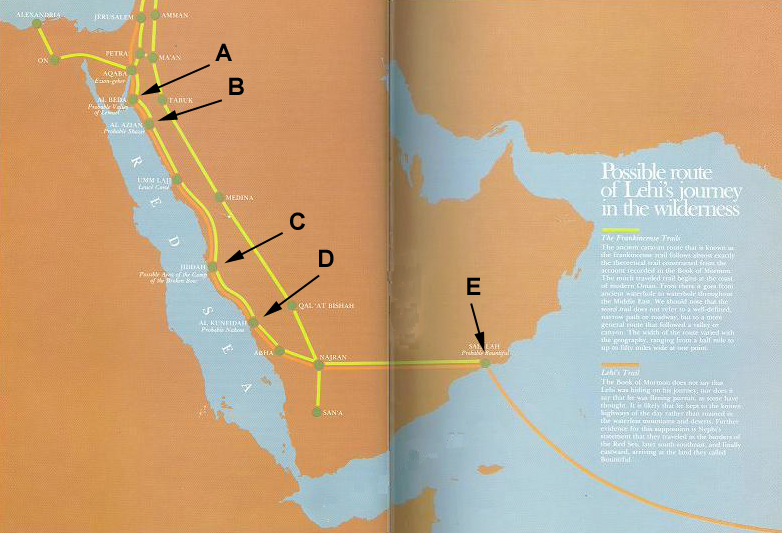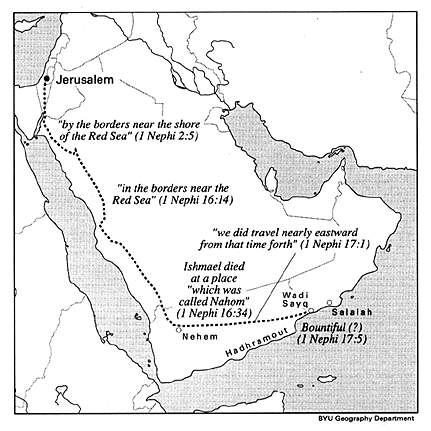FAIR Answers—back to home page
Question: What Old World sites match those on Lehi's journey as described in the Book of Mormon?
The Hilton model (1976): Models developed by LDS researchers predicted geographic locations long before they were located
Models developed by LDS researchers predicted geographic locations long before they were located. Therefore, geographical correlates discovered later are confirmed predictions made by the geographical model offered by the Book of Mormon.

Figure 1: Scan from Hilton and Hilton (1976), pp. 22–23 showing hypothesized route of Lehi's party. (Labels have been added to original graphic for clarity.)
In the scan pictured here, hypothesized sites for Lehi's journey include:
The Hilton's acknowledged their debt to the writings of Hugh Nibley, which pushes the essentials of their model back to 1950.[1]
The Hilton's model—like all such models constructed from a text that gives only approximate distances at many points—has been tweaked slightly, but the basic layout of the journey has been remarkably stable. Most importantly, the subsequent findings which support the authenticity of the Book of Mormon's account fit neatly into Nibley's schema and the Hilton's model.
In 1986, Eugene England summarized 23 details of Arabian geography predicted by the Book of Mormon
In 1986, Eugene England summarized 23 details of Arabian geography predicted by the Book of Mormon, and concluded that Joseph Smith would have not had access to the necessary information to forge so many inter-related facts. England's list read:

Figure 2: BYU Geography Department map of the Lehi party's journey from Jerusalem to Old World Bountiful.
- The route south to Aqaba is an anciently primary way out of Jerusalem.
- The ancient route, the Frankincense Trail, leaves the beach coast at Aqaba, so it is "near" the Red Sea; then it returns to it, so it is "nearer."
- The location of a major oasis about three days' journey along the trail from Aqaba.
- The location there of an impressive valley that could be used for poetic metaphor and
- of a continually flowing river that
- flows into an arm of the Red Sea called anciently a "fountain" and
- is capable of supporting extended settlement and growth of crops.
- Four days from this oasis, in a south-southeast direction, is another major oasis where
- wild animals that can be hunted with bow and arrow begin to be available.
- Further in the same direction, still along the Frankincense Trail that is in this whole area the only tenable route, with anciently dug or natural water holes at regular intervals,
- the area (north and south of modern Jiddah) becomes more inhospitable, a source of "much affliction," with fewer water holes,
- many sand storms and metal-destroying salt air and humidity where a steel bow would break and wooden ones lose their spring but
- where there is excellent pomegranate wood for new bows and
- a mountain where wild game is plentiful.
- Many days further in the same direction is another major oasis capable of supporting a caravan through a growing season, and
- this is where the Frankincense Trail turns sharply to the east and then
- skirts the notorious "Empty Quarter," the worst desert in Arabia, another period of "much affliction" to the group and
- a place where danger from Bedouin raiders could require traveling without firebuilding.
- There is, exactly where the direct route east intercepts the southern Arabian coast, a unique fertile area of fruit and wild honey, with
- a gentle beach and yet nearby high cliffs dropping into deep water,
- mountains nearby with iron ore for toolmaking,
- sycamore-fig trees growing on the mountains that are excellent for shipbuilding and
- strong monsoon winds used anciently for sailing to India and out into the Pacific Ocean.[2]
Notes
- ↑ Lynn M. Hilton and Hope Hilton, In Search of Lehi's Trail (Salt Lake City: Deseret Book, 1976), 21. ISBN 0877476306. Also published in Ensign 6 (September 1976): off-site and (October 1976): off-site. The Hiltons cite Nibley's 1950 Improvement Era articles.
- ↑ Eugene England, "Through the Arabian Desert to a Bountiful Land: Could Joseph Smith Have Known the Way?," in Book of Mormon Authorship: New Light on Ancient Origins, edited by Noel B. Reynolds and Charles D. Tate (eds.), (Provo, Utah : Religious Studies Center, Brigham Young University ; Salt Lake City, Utah : Distributed by Bookcraft, 1996 [1982]), 152. ISBN 0884944697 GospeLink

